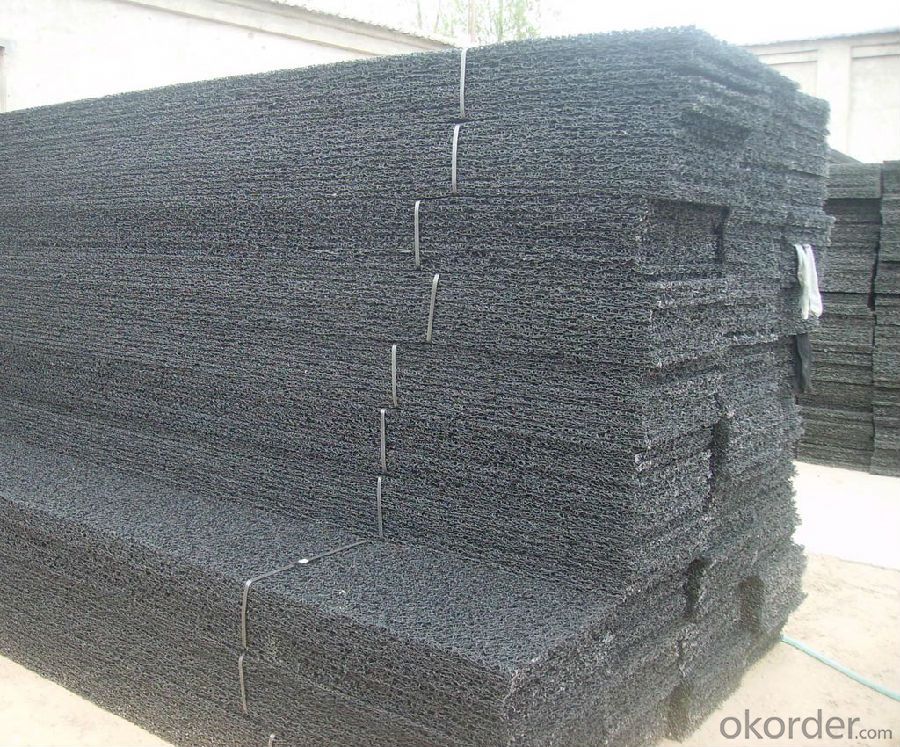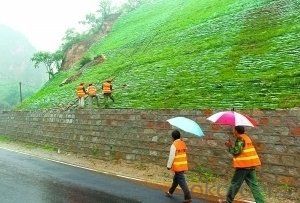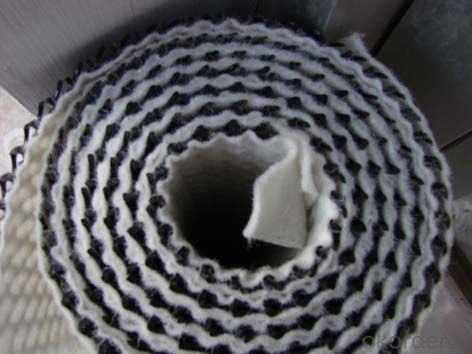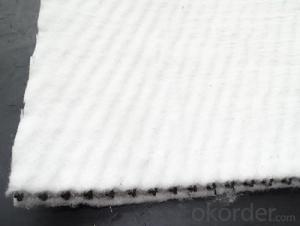Composite Drainage Network with CE Certification
- Loading Port:
- Qingdao
- Payment Terms:
- TT OR LC
- Min Order Qty:
- 10000 pc
- Supply Capability:
- 500000 pc/month
OKorder Service Pledge
OKorder Financial Service
You Might Also Like
Description Of Composite Drainage Network
Tri-dimension composite genet for drainage is a new type of geosynthetics.
Its made of atri-dimension geonet coated with geotextile on both sides. Network core consists of a tri-dimension thick vertical rib, and a rip on top and bottom .
It can drain underground water quickly, also there is a protection system,which can block the capillary water under high load. At the same time, it can also reinforce and isolate of foundation.
Main Features of Composite Drainage Network
1.Excellent drainage function, can bear long time hige press load
2.High tensile and shear strength
3.Reduce the rate geotextile embedding into the core of geonet, can protect long time stable water conductivity
4.Tri-dimension composite geonet for drainage can bear more than kpa compression load
5.Its anti-compression capacity is much larger than common geonet for drainage.
Specifications of Composite Drainage Network
Tri-dimension composite geonet for drainage
Drainage netwrok core | units | Specification | |||
Unit weight | g/m2 | 750 | 1000 | 1300 | 1600 |
Thickness OV=20kpa | mm | 5.0 | 6.0 | 7.0 | 7.6 |
Hydraulic conductivity | m/s | K x 10 -4 | K x 10 -4 | K x 10 -3 | K x 10 -3 |
Elongation | % | <50 | <50 | <50 | <50 |
Tensile strength ( core network) | KN/m | 8 | 10 | 12 | 14 |
Geotextile | g/m2 | 200-200 | 200-200 | 200-200 | 200-200 |
Composite Drainage Network Images





FAQ
1. Do you supply free samples for customers?
Yes,we will supply free samples for you.Please send your address for us.
2. How Many years experience do you have?
We have been exported to more than 20 countries in the past 15 years.
3. How long do we usually reply your request?
We always reply our customer within 24 hours.
- Q:Can geotextiles be used in green roof systems?
- Yes, geotextiles can be used in green roof systems. They can serve multiple purposes such as providing drainage, filtration, and separation layers. Geotextiles help to control water flow, prevent soil erosion, and promote healthy plant growth in green roofs.
- Q:What are the installation techniques for geotextiles?
- There are several installation techniques for geotextiles, depending on the specific application. Common techniques include anchoring the geotextile with pins or stakes, using mechanical or adhesive methods to secure overlapping sections, and incorporating it into the soil through tilling or mixing. The choice of installation technique will depend on factors such as the intended function of the geotextile, the site conditions, and the desired longevity of the installation.
- Q:Can geotextiles be used in erosion control blankets?
- Yes, geotextiles can be used in erosion control blankets. Geotextiles, which are permeable fabrics, are commonly used in erosion control blankets to prevent soil erosion by stabilizing the soil, reducing water velocity, and promoting vegetation growth. These blankets are typically made of biodegradable materials and are designed to provide temporary erosion control until vegetation is established.
- Q:How do geotextiles contribute to groundwater recharge?
- Geotextiles contribute to groundwater recharge by acting as a permeable barrier that allows water to infiltrate the soil while preventing soil erosion. This helps to retain and replenish groundwater levels by promoting the natural process of water percolation and recharge into aquifers.
- Q:What are the different geotextile erosion control products available in the market?
- There are several geotextile erosion control products available in the market, including geotextile mats, geotextile tubes, geotextile blankets, and geotextile grids. These products are designed to prevent soil erosion by providing stability, filtration, and reinforcement to the soil. Geotextile mats are typically used for slope stabilization, while geotextile tubes are commonly used for shoreline protection and dewatering applications. Geotextile blankets are used for erosion control on steep slopes and channels, and geotextile grids are often used for soil stabilization in areas with heavy traffic or high loads.
- Q:Geotextile is what kind of material in the construction? Is it a hydroelectric material?
- Geotextile is what kind of material in the construction? Is it a hydroelectric material?
- Q:Can geotextiles be used in geotextile wrapped columns?
- Yes, geotextiles can be used in geotextile wrapped columns. Geotextiles are commonly used as a wrapping material for columns in geotechnical engineering applications. They provide reinforcement, prevent soil erosion, and enhance the stability of the column structure.
- Q:How do geotextiles help in filtration of stormwater?
- Geotextiles help in the filtration of stormwater by acting as a barrier that allows water to pass through while trapping sediment, debris, and pollutants. They prevent these contaminants from entering the drainage system, improving water quality and reducing the risk of clogging in stormwater infrastructure. Additionally, geotextiles promote infiltration, allowing stormwater to percolate into the underlying soil, thus replenishing groundwater levels and reducing the chances of flooding.
- Q:Can geotextiles be used in erosion control in river channel stabilization?
- Yes, geotextiles can be used in erosion control in river channel stabilization. Geotextiles are engineered fabrics that can be placed in river channels to prevent soil erosion and stabilize the riverbanks. They help in reducing the velocity of water flow, trapping sediment, and promoting vegetation growth, thereby effectively controlling erosion in river channels.
- Q:What are the advantages of using geotextiles in stormwater management systems?
- Geotextiles offer several advantages in stormwater management systems. Firstly, they act as a filtration barrier, preventing sediment and pollutants from entering water bodies, which helps maintain water quality. Secondly, geotextiles enhance the stability of soil and prevent erosion by providing reinforcement. They also promote water infiltration and reduce surface runoff, which aids in groundwater recharge. Additionally, geotextiles are cost-effective and easy to install, making them a practical choice for stormwater management. Overall, the use of geotextiles in stormwater management systems contributes to improved water quality, reduced erosion, and efficient water infiltration.
1. Manufacturer Overview |
|
|---|---|
| Location | |
| Year Established | |
| Annual Output Value | |
| Main Markets | |
| Company Certifications | |
2. Manufacturer Certificates |
|
|---|---|
| a) Certification Name | |
| Range | |
| Reference | |
| Validity Period | |
3. Manufacturer Capability |
|
|---|---|
| a)Trade Capacity | |
| Nearest Port | |
| Export Percentage | |
| No.of Employees in Trade Department | |
| Language Spoken: | |
| b)Factory Information | |
| Factory Size: | |
| No. of Production Lines | |
| Contract Manufacturing | |
| Product Price Range | |
Send your message to us
Composite Drainage Network with CE Certification
- Loading Port:
- Qingdao
- Payment Terms:
- TT OR LC
- Min Order Qty:
- 10000 pc
- Supply Capability:
- 500000 pc/month
OKorder Service Pledge
OKorder Financial Service
Similar products
New products
Hot products
Related keywords

































